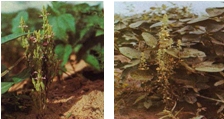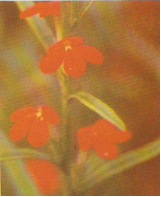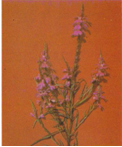Weeds - cowpea
Contributors to this section: IITA, Nigeria (M. Ayodele, L. Kumar).
|
Contents: |
Scientific name
Striga gesnerioides
Other scientific names
Striga orobanchoides R.Br. Benth. (1836)
Buchnera orobanchoides R.Br. (1814)
Buchnera hydrabadensis Roth. (1821)
Importance
High
Significance
S. gesnerioides is a severe pest of cowpea in Senegal, Mali, Togo, Benin, Burkina Faso, Ghana, Nigeria, Niger, Cameroon and Chad, causing significant loss of yield. Bottenburg, in 1995, reported that during a farm survey in the Kano , Nigeria, at least 25% of farmers reported severe infestation by S. gesenerioides in cowpea fields. Also Emechebe et al. (1991) reported that many farmers' fields across northern Nigeria had been 'completely blighted' by the weed.
Symptoms
The flowering, fruiting and vegetative growing stages, the leaves and whole plant of the cowpea is affected by this parasite.The symptoms are usaully not obvious at the start of infestation but later, the leaves suffer from veinal chlorosis, withering.
Pod : poor podding
Whole plant : reduced growth, dwarfing, early senescence.
 Striga gesnerioides(photos:IITA) |
Hosts
Has a wide host range including annual, perennial and woody species. Vigna unguiculata (cowpea), Ipomoea batatas (sweet potato), Nicotiana tabacum (tobacco), and Oryza glaberrima (African rice) are the main economic host.
Geographic distribution
S. gesnerioides is widely distributed in Africa. It has also been reported in Cambodia, India, Japan, pakistan, Saudi Arabia, Sri Lanka, USA Guyana and Australia. Holm et al. (1979).
Biology and transmission
S. gesnerioides is an obligate parasite with minute seeds. Not capable of establishing without the assistance of a host plant. The parasite has an under developped root system. Each plant produces about 60,000 (Hartman and Tanimonure, 1991). On cowpea, the stems branch mainly below the soil (Parker and Riches, 1993). S. gesnerioides developes an infective hyphae( haustorium )of about 3-4 cm in diameter on cowpea. The forms attacking cowpea have mauve to white flower colours.
Detection/indexing methods used at IITA
Field inspection during active growth, uproot plants and check for nodules of young Striga seedlings and point of haustorium attachment to cowpea seedlings.
- Detection and inspection of Striga gesnerioides using Berner et al. (1994) method which is
- sampling the bottom of sacks, elutriation of samples in turbulent flowing water and collection of seeds and other particles on a 90-µm mesh sieve.
- Striga seeds are then separated from heavier particles by suspension in a solution of potassium carbonate of specific gravity 1.4 in a separating column.
- Striga seeds collected at the interface are then transferred to a 60-µm mesh for counting.
- Use light microscope for identification
Treatment/control
Cutural method
- Crop rotation, planting of trap crops
Host plant Resistance
- Resistant lines have been developped in IITA and are available on demand
Procedures in case of positive test at IITA
- Discard and incinerate all contaminated consignment
- Prohibited for international distribution in conformity to National Plant Protection and quarantine regulations
References and further reading
Berner DK, Awad AE, Aigbokhan EI. 1994. Potential of imazaquin seed treatment for control of Striga gesnerioides and Alectra vogelii in cowpea (Vigna unguiculata). Plant Disease, 78(1):18-23.
Berner DK, Cardwell KF, Faturoti BO, Ikie FO, Williams OA. 1994. Relative roles of wind, crop seeds, and cattle in dispersal of Striga spp. Plant Disease, 78(4):402-406.
Berner DK, Williams OA. 1998. Germination stimulation of Striga gesnerioides seeds by hosts and nonhosts. Plant Disease, 82(11):1242-1247.
Bottenberg H. 1995. Farmers' perceptions of crop pests and pest control practices in rainfed cowpea cropping systems in Kano, Nigeria. International Journal of Pest Management, 41(4):195-200
Emechebe AM, Singh BB, Leleji OI, Atokple IDK, Adu JK. 1991. Cowpea-striga problems and research in Nigeria. Combating striga in Africa: proceedings of the international workshop held in Ibadan, Nigeria, 22-24 August 1988., 18-28
Hartman GL, Tanimonure OA. 1991. Seed populations of Striga species in Nigeria. Plant Disease, 75(5):494-496.
Holm L, Pancho JV, Herberger JP, Plucknett DL. 1979. A geographical atlas of world weeds. New York, Chichester (), Brisbane, Toronto, UK: John Wiley and Sons
Parker C, Riches CR. 1993. Parasitic Weeds of the World: Biology and Control. Wallingford, UK: CAB International
Scientific name
Striga asiatica
Importance
High
Significance
S. asiatica is considered to be a serious weed in Pakistan, India, South Africa, Zimbabwe, Zambia and Mauritius ( Holm et al. (1979), in parts of Togo (Agbobli and Huguenin, 1987), in S. Ethiopia (Matiyas Mercuria, 1999), in Tanzania (Mbwqaga, 1996), in Botswana (Riches, 1989), in Malawi (Kroschel et al., 1996), in Mozambique (Davies, 1999) and in Madagascar (Elliott et al., 1993).
Overall losses in infested fields of southern India were estimated to be about 21%. And losses of maize due to S. asiatica in Malawi were estimated at 28% in infested fields and 4.5% for the country as a whole (Kroschel et al., 1996).
Symptoms
At the early stage of infection, symptoms of attack by S. Asiatica on hosts are indistinguishable from those caused by drought.
Striga asiaticaattacks all plant stages: seedling, vegetative, leaves, stems and the whole plant. Symptoms expressed on:
Leaves : curling, abnormal forms; yellowing, scorching of the leaf borders, wilting and 'burning' of the foliage.
Stems : abnormal growth.
Roots : growth is increased in infected plants (Patterson, 1990)
Whole plant : dwarfing; early senescence. Crop failure.
 Striga asiatica (photo:IITA) |
Hosts
S. asiatica is an obligate parasite and cannot develop without a suitable host plant. It is known to attack major hosts such as soybean, Eleusine coracana (finger millet), Oryza sativa (rice), Paspalum scrobiculatum (ricegrass paspalum), Pennisetum glaucum (pearl millet), Poaceae (grasses), Saccharum officinarum (sugarcane), Setaria italica (foxtail millet), Sorghum bicolor (sorghum), Zea mays (maize). It also attacks cotton, peanut, and some broad leaf crops; sunflower, tomatoes, some legumes.
Geographic distribution
S. asiatica is said to be indigenous in most of the countries in which it now occurs, (Carter et al., 1996. The weed is widely spread in Asia, China, India , Indonesia, Japan, Malaysia, Africa, USA, Australia and New Zealand.
Biology and transmission
S. asiatica is an annual; parasitic; broadleaved; herbaceous; seed propagated weed having variable species with many self-perpetuating forms which differ in stature, flower colour and host preference. The flower colour varies from red, orange, or yellow in Africa; pink, white, yellow, or purple in Asia. In South and East Africa, they are generally red/yellow-flowered.
This flowers give way to swollen seeds pods, each containing thousands of microscopic seeds. S. asiatica which is self pollinated reproduces by seed only. Seed longevity of at least 14 years has been recorded in the field in both South Africa (Saunders, 1933) and USA (Bebawi et al., 1984.
The weed seed requires stimulant from the host plant for growing into a seedling. In the absence of a host, the seedling dies within a few days. Until emergence, the parasite seedling draws all its nutrients from the host. It continues to be dependent on the host plant for vigorous growth (de la Harpe et al., 1979
Apart from sapping the host of water and nutrients, S. asiatica has a profound physiological effect on the host. It produces some substances which are toxic to the hosts.(Musselman et al., 1982).The underground stems are round with scale-like leaves and white but turn blue when exposed to air.
This weed is favoured by high temperatures of 30-35°C; dry, infertile, low nitrogen soil conditions are optimal for both conditioning and germination, (Farina et al., 1985. The weed can develop over a wide range of temperatures from 22°C upwards and the dormant seeds can survive prolonged freezing (Robinson, 1960).
Detection/indexing methods used at IITA
Field inspection during active growth, uproot plants and check for nodules of young Striga seedlings and point of haustorium attachment to cowpea seedlings.
- Detection and inspection ofStriga asiatica using Berner et al. (1994) method : sampling the bottom of sacks, elutriation of samples in turbulent flowing water and collection of seeds and other particles on a 90-µm mesh sieve.
- Striga seeds are then separated from heavier particles by suspension in a solution of potassium carbonate of specific gravity 1.4 in a separating column.
- Sound seeds collected at the interface are then transferred to a 60-µm mesh for counting.
- Use light microscope for identification
Treatment/control
Cutural method
- Crop rotation, planting of trap crops
Host plant Resistance
- Resistant lines have been developped in IITA and are available on demand
Procedures in case of positive test at IITA
- Discard. Discard and incinerate all contaminated consignment
- Prohibited for international distribution in conformity to National Plant Protection and quarantine regulations
References and further reading
A handbook of West African Weeds. International Institute of Tropical Agriculture (IITA) Ibadan Nigeria. 394 pp.
Agbobli CA, Huguenin B. 1987. Agronomic evaluation of the parasitism problem of Striga asiatica on maize in southern Togo. Proceedings of the 4th international symposium on parasitic flowering plants. Pp 11-26.
Bebawi FF, Eplee RE, Harris CE, Norris RS. 1984. Longevity of witchweed (Striga asiatica) seed. Weed Science, 32(4):494-497
Carter RJ, Cooke DA, Barker WR, Csurhes SM. 1996. Occurrence and control of Striga, Orobanche and Cuscuta in Australia. In: Moreno T, Cubero JI, editors. Advances in Parasitic Plant Research, Proceedings of the 6th International Parasitic Weed Symposium, Cordoba, Spain 1996. Pp 801-807.
Davies G. 1999. Striga in Mozambique. Haustorium, 35: 5.
Elliot PC, Clarisse RN, Beby R, Josue HR.993. Weeds in rice in Madagascar. International Rice Research Notes, 18(1):53-54
Farina MPW, Thomas PEL, Channon P.1985. Nitrogen, phosphorus and potassium effects on the incidence of Striga asiatica (L.) Kuntze in maize. Weed Research, UK, 25(6):443-447
Harpe AC de la, Visser JH, Grobbelaar N.1979. The chlorophyll concentration and photosynthetic activity of some parasitic flowering plants. Zeitschrift fur Pflanzenphysiologie, 93(1):83-87
Holm L, Pancho JV, Herberger JP, Plucknett DL.1979. A geographical atlas of world weeds. New York, Chichester, Brisbane, Toronto, UK: John Wiley and Sons
Kroschel J, Jost A, Sauerborn J.1999. Insects for Striga control - possibilities and constraints. Advances in Parasitic Weed Control at On-farm Level. Vol. 1. In: Kroschel J, Mercer-Quarshie H, Sauerborn J, editors. Joint Action to Control Striga in Africa. Weikersheim, Germany: Margraf Verlag, 117-132.
Kroschel J, Mercer-Quarshie H, Sauerborn J.1999. Advances in parasitic weed control at on-farm level. Vol 1: Joint action to control Striga in Africa., 310 pp.
Matiyas Mekuria.1999. Major weed species in the Southern Nations, Nationalities and Peoples Region. Arem, 5: 11-13.
Mbwaga AM.1996. Status of Striga species in Tanzania: occurrence, distribution, and on-farm control packages. Drought-tolerant crops for southern Africa. Proceedings of the SADC/ICRISAT regional sorghum and pearl millet workshop, Gaborone, Botswana, 25-29 July 1994. Pp 195-200.
Musselman LJ, Parker C, Dixon N.1981. Notes on autogamy and flower structure in agronomically important species of Striga (Scrophulariaceae) and Orobanche (Orobanchaceae). Beitrage zur Biologie der Pflanzen, 56:329-343.
Patterson DT.1990. Effects of environment on growth and reproduction of witchweed. In: Sand PF, Eplee RE and Westebrooks RG, editors. Witchweed Research and Control in the United States. Weed Science of America, Champaign, 68-80.
Riches C R.1989. The biology and control of witchweeds of grain legume and cereal crops in Botswana. In: Research Projects 1983-1986 - Summaries of the Final Reports. First Programme Science and Technology for Development, Sub-programme: Tropics and Sub-tropical Agriculture. Commission of the European Communities, Brussels. pp 318-322.
Robinson EL.1960. Growth of witchweed (Striga asiatica) as affected by soil types and air temperature. Weeds, 8:576-581.
Saunders AR.1933. Studies in phanerogamic parasitism, with particular reference to Striga lutea Lour. South African Department of Agriculture, Science Bulletin 128, 56 pp.
Scientific name
Striga hermonthica
Importance
High
Significance
S. hermonthica is said to be responsible for more crop loss in Africa than any other individual weed species.
It is estimated that over 5 million ha of crops of sorghum, millets and maize have been affected in six countries of West Africa alone (Sauerborn, 1991)
One plant of S. hermonthica per host plant is estimated to cause approximately 5% loss of yield (Parker and Riches, 1993)
High infestations can cause total crop failure. Overall yield losses are estimated at 21% of all sorghum in northern Ghana, 10% of all cereals in Nigeria, 8% in Gambia and 6% in Benin (Sauerborn, 1991
Other countries seriously affected include Cameroon, Cote d'Ivoire, Burkina Faso, Niger, Mali, Senegal, Togo, Sudan, Ethiopia, Kenya, Uganda and Tanzania.
Symptoms
This parasitic weed attacks all the plant stages: and plant parts, flowering , podding , pre-emergence, seedling and vegetative phase, the leaves, stems and whole plant. Symptoms exibited on the various plant parts are on :
Leaves: yellowish blotches ,abnormal patterns, wilt, reduction in number,
Inflorescence: delayed/ prevent development.
Stems: shortened, abnormal growth.
Root: wilting
Whole plant: dwarfing; early senescence
 Striga hermonthica (photo:IITA) |
Hosts
The infestation by this parasitic weed, although , limited to the family Graminea, it has been reported to infest groundnut, cowpea, lablab and soyabean, results obtained in pots experiments by Andrews (1946).
The major hosts of this parasitic weed are Eleusine coracana (finger millet), Oryza sativa (rice), Panicum (millets), Saccharum officinarum (sugarcane), Sorghum bicolor (sorghum), Zea mays (maize) and the minor hosts are Eragrostis tef (teff), Hordeum vulgare (barley). Two identified wild hosts are Rottboellia cochinchinensis (itch grass), Sorghum halepense (Johnson grass) Parker and Riches, (1993), reported that, there are forms which attack sorghum but not pearl millet and vice versa.
Geographic distribution
Cambodia, Saudi Arabia, Yemen, Africa South of Sahara.
Musselman and Hepper, (1986) reported that S. hermonthica may have developed in north-east Africa, but appears to have reached most suitable ecologies in Western and Central Africa long ago, while its spread in Ethiopia had just occurred in the past 100 years.
Biology and transmission
S. hermonthica is an erect, branched obligate semi-parasitic, annual herb growing up to 60cm high.It has a weak root system that is incapable of absorbing materials from the soil.
Branches develop from lower nodes of the plant, spreading and developing secondary haustoria and attachments to make contact with host roots.
A single plant can produce 50,000 seeds and remain viable for 14 years (Visser, 1981).
In the absence of a stimulant, the seeds usually undergo some degree of secondary dormancy'.Seed germination occurs within 24 h of exposure to stimulant. The seedling root grows to 4 or 5 mm only before dying in the absence of a host. On contact with a host root, elongation stops and sticky hairs develop, anchoring to the root surface while the intrusive organ develops and penetrates the cortex and endodermis, to make connections with the host xylem (Press et al., 1987).
The rapid transfer of materials from host to parasite depends on high transpiration rate of the parasite. The parasite has a permanent opened stomata.
Germination and growth are generally favoured by high temparatures of 30-35°C, low soil nitrogen, low soil moisture,and dry conditions of the air (Pieterse, 1991).
Detection/indexing methods used at IITA
- Sampling from the bottom of sacks,
- Elutriation of samples in turbulent flowing water
- Collect seeds and other particles on a 90 µm mesh sieve.
- Striga seeds are then separated from heavier particles by suspension in a solution of potassium carbonate of specific gravity 1.4 in a separating column.
- Sound seeds collect at the interface and are transferred to a 60 µm mesh for counting.
Treatment/control (IPM)
- Use of tolerant varieties,
- Rotation with non hosts leguminous crops
- Use of trap crops
- Enhance soil fertility using organic, inorganic or green manure.
Procedures in case of positive test at IITA
- Discard. Harvested crop seeds from such fields and multiplication sites not acceptable for international distribution (Prohibition by National Plant Quasrantine Organizations).
References and further reading
Akobundu IO, Agyakwa CW. 1998. A handbook of West African Weeds. International Institute of Tropical Agriculture (IITA) Ibadan Nigeria.394 pp.
Andrews FW. 1946. The parasitism of Striga hermonthica Benth. on leguminous plants. Annals of Applied Biology, 34:267-275.
Berner DK, Cardwell KF, Faturoti BO, Ikie FO, Williams OA. 1994. Relative roles of wind, crop seeds, and cattle in dispersal of Striga spp. Plant Disease, 78(4):402-406
Musselman LJ, Hepper FN. 1986. The witchweeds (Striga, Scrophulariaceae) of the Sudan Republic. Kew Bulletin, 41:205-221.
Parker C, Riches CR. 1993. Parasitic weeds of the world: biology and control. Wallingford, UK: CAB International.
Pieterse AH. 1991. The effect of nitrogen on the germination of seeds of Striga hermonthica and Orobanche crenata. Progress in Orobanche research. Proceedings of the international workshop on Orobanche research, Obermarchtal, Germany, 19-22 August 1989. Pp 115-124.
Press MC, Shah N, Tuohy JM, Stewart GR. 1987. Carbon isotope ratios demonstrate carbon flux from C4 to C3 parasite. Plant Physiology, 85(4):1143-1145.
Viser, JH. 1981. South African parasitic flowering plants. CRC Press, Boca Raton FL.
Comments
- No comments found





Leave your comments
Post comment as a guest